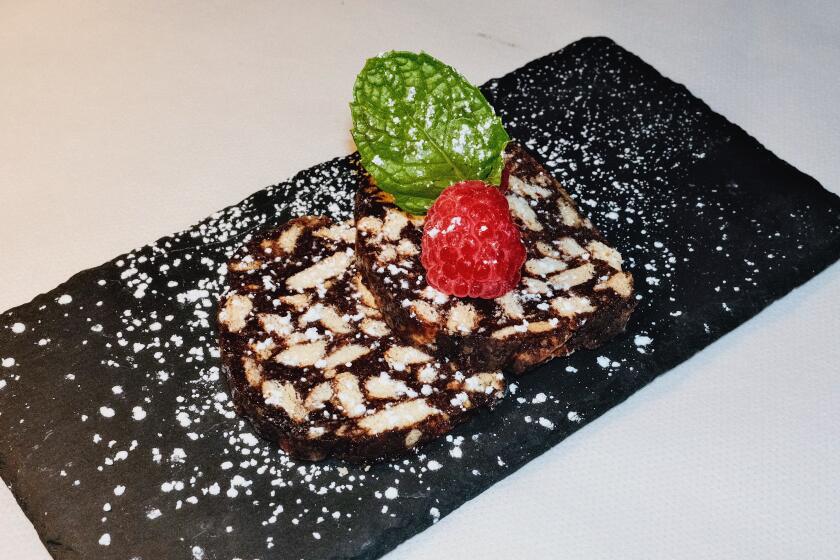Fanny's strawberry-orange compote

- Share via
There are very few things as flat-out gorgeous in market stalls now as blood oranges, those glorious citrus orbs that darken over the course of spring until the exterior can be almost as deep red as the fruit inside. But they won’t be here for long, as this dark color also heralds the approaching end of the season: A folksy caveat marks Easter as a the signal of the end, the blood of Christ a reminder that the blood oranges will soon be gone from the trees.
Moros, the type most widely grown in California and likely the only ones you’ll find this late in the season (which started in January), have only a few weeks left. But now’s the perfect time to get them. Earlier in the season, before they’ve had time to ripen thoroughly, they’re more tart and tangy. You have to search out the darker ones, rolling them around in their bins and crates like enormous avant-garde marbles. No need for that now, though; they’re almost uniformly at their peak.
“I don’t bring the oranges until they’re really dark on the outside,” says Armando Garcia of Garcia Organic Farm in Fallbrook at the Santa Monica farmers market Saturday. He says they’re sweetest now, when the colors from the inside have bled out until the skin gets almost purple. But, as with all fruit, it’s a delicate balance. You don’t want to wait too long: The fruit begins to dry out after it reaches its peak, and the flavor can lose its bright citrus notes and become murky.
This is a terrific season for blood oranges, as it’s the less productive year of what fruit producers call an “alternate bearing” crop. Last year’s yield was huge, so this year the crop is much smaller, Bob Polito of Polito Family Farms in Valley Center explains. But he also says that a smaller crop can often produce more desirable fruit: “This year the quality seems to be better; they’re darker, and when they have that color, they’re the best.”
So grab them now, as they’re easy to find and pretty inexpensive: around $2 per pound at farmers markets and some grocery stores.
You can eat them out of hand as you would any orange, or peel and section them, or cut them into glorious segments like jeweled wedges. They’re fabulous tossed into a fruit salad with the strawberries that are also at their peak. Or, with a handful of arugula and a crumble of goat cheese, they’re a delightful first course, particularly with a vinaigrette made with the garnet-colored juice.
Juice them to make a fresh, tangy sorbet or use them for a stunning blood-red martini, a curl of the rind like a tongue of flame inside.
There aren’t too many chefs who get as excited about blood oranges as Lindsey Remolif Shere, longtime pastry chef, now retired, at Berkeley’s Chez Panisse. She loves them in sorbets and compotes, in tarts and cold citrus soups. “To me, blood oranges have a flavor of raspberries that’s sometimes quite strong; their flavor is richer and more complex than plain navels or Valencias,” she writes in a recent e-mail. She should know: Not content simply to write a dessert cookbook, she and the chefs at Chez Panisse penned one about fruit as well.
Shere’s blood orange tart, from “Chez Panisse Desserts,” is gorgeous, with the blood orange segments arranged like a wide-open rose on the top. The flavor of the blood oranges plays beautifully with a hidden, thin layer of caramel that gives unexpected crunch. A pillowy pastry cream and buttery short crust shell pull it all together.
But if you want something more market-sudden, try the compote from “Chez Panisse Fruit.” A bowl of strawberries and crimson citrus segments, with a thatch of candied peel like a little nest on top, it’s a simple tribute to fruit at the peak of its season. It looks stunning, like a jewelry box filled with garnets, and the flavors are remarkable. And it’s so easy, especially if you candy the peel ahead, that it comes together in a flash.
Which is a good thing, considering how little time there is left in the season. You can’t stockpile blood oranges in the fridge the way you can Meyer lemons -- they dry out too quickly. So do what many chefs do and buy them now, juice them and freeze the juice for use year-round. Frozen in ice cube trays, it’ll last for months.
Remove about three-fourths of the zest from one of the oranges with a large-grade zester or peel strips of zest with a vegetable peeler and cut into a fine julienne. Measure one-half cup sugar and the water into a saucepan and bring to a boil to dissolve the sugar. Add the tiny strips of zest, reduce the heat, and simmer for about 30 minutes, until the peel is tender and the syrup has reduced and thickened slightly. Let cool.
Rinse the strawberries and dry them gently. Hull and slice them about one-fourth-inch thick into a bowl. Cut away all the peel from the oranges: Slice off the tops and bottoms and cut away all the rind. Remove skinless sections of the oranges by sliding a sharp paring knife alongside the membranes and prying out the segments into the bowl with the strawberries. Squeeze the juice from the remaining oranges, sprinkle with 2 tablespoons sugar, and mix gently.
To serve, spoon the compote into serving glasses or dishes, sprinkle some curls of the candied peel on top, and drizzle a teaspoon of the syrup from the peel over the compote.
Get our Cooking newsletter
Get a taste of Los Angeles — and the world — with recipes and kitchen tricks from the L.A. Times’ Cooking newsletter.
You may occasionally receive promotional content from the Los Angeles Times.
















